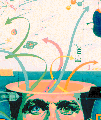

Synesthesia as a physical experience is distinct from the everyday cross-sensory associations familiar to [psychophysics], as well as from [metaphor] and [artistic contrivances] that sometimes use the word "synesthesia" to describe their deliberate multisensory joinings.
Although medicine has known of synesthesia for three centuries, it keeps forgetting that it knows. After decades of neglect, a revival of inquiry is under way. Neuroscience is particularly curious because of what synesthesia might tell us about consciousness, the nature of reality, and the relationship between reason and emotion.
Although the five senses yield 20 possible pair-wise combinations, some synesthetic combinations are much more common than others. Yoking of sight with sound is by far most frequent, touch and taste less so, and smell is least often involved. Color, movement, and geometric shape are typical properties of the parallel sensation(s). Replication and symmetry of the percepts are usual. In colored hearing synesthesia, words, voices, environmental sounds, or music trigger the perception of an involuntary photism that is seen outside the body. In a case I called geometric taste (i.e., taste-touch synesthesia) the taste of mint caused subject MW to feel, but not see, a cold, smooth, curved shape in front of him.
We often emphasize just two senses, though multi-modal synesthesia also occurs. Individuals mention that a third or fourth sense participates, but "not as often" as the main two that are joined. It is important to distinguish that synesthetic percepts are neither metaphoric nor pictorial: they are concrete, generic, and unelaborated. By GENERIC, I mean that synesthetes see blobs, spirals, and lattice shapes:

They palpate smooth or rough textures; taste agreeable or disagreeable flavors, such as salty, sweet, or metallic. They do not see beautiful scenery, taste chicken soup, feel a sponge, or experience any specific object. Sensations never go beyond this elementary, unembroidered level to become specific exemplars. If they did they would no longer be synesthesia--but rather well-formed hallucinations or figurative mental images. [Click on FORM CONSTANTS for elaboration.]
Certain features co-occur with synesthesia: females predominate (by at least 2 to 1), as does non-right-handedness; the trait runs in families, and memory is superior while math and spatial navigation suffer. Psychophysical experiements, pharmacologic tests, and measurements of cerebral metabolism indicate that synesthesia is a left-hemisphere function. It relies on limbic brain elements more than cortex; the hippocampus is critical for its experience. Five clinical features comprise its diagnosis.
Epileptic synesthesia is a good example of acquired synesthesia; it occurs in 4% of temporal lobe seizures and seems due to the actual electric discharge. Visual, auditory, tactile, gustatory (and, much less often, olfactory) sensations may combine with visceral sensations, vertigo, and involuntary movement, as in these 3 examples:
Cytowic, R.E. _Synesthesia: A Unity of the Senses_ New York: Springer- Verlag, 1989.

Funded, in part, by the Council for the Arts at MIT